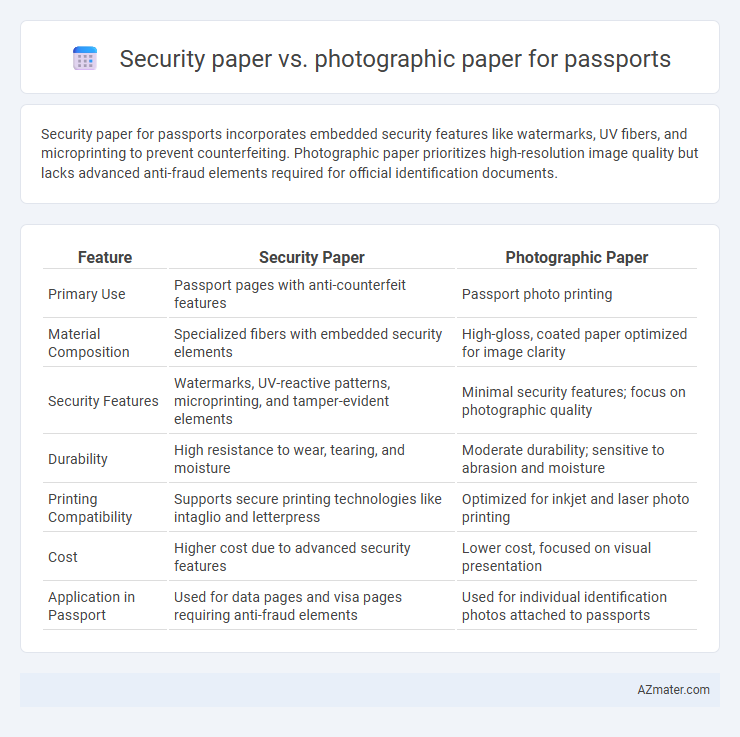Security paper for passports incorporates embedded security features like watermarks, UV fibers, and microprinting to prevent counterfeiting. Photographic paper prioritizes high-resolution image quality but lacks advanced anti-fraud elements required for official identification documents.
Table of Comparison
| Feature | Security Paper | Photographic Paper |
|---|---|---|
| Primary Use | Passport pages with anti-counterfeit features | Passport photo printing |
| Material Composition | Specialized fibers with embedded security elements | High-gloss, coated paper optimized for image clarity |
| Security Features | Watermarks, UV-reactive patterns, microprinting, and tamper-evident elements | Minimal security features; focus on photographic quality |
| Durability | High resistance to wear, tearing, and moisture | Moderate durability; sensitive to abrasion and moisture |
| Printing Compatibility | Supports secure printing technologies like intaglio and letterpress | Optimized for inkjet and laser photo printing |
| Cost | Higher cost due to advanced security features | Lower cost, focused on visual presentation |
| Application in Passport | Used for data pages and visa pages requiring anti-fraud elements | Used for individual identification photos attached to passports |
Introduction: Understanding Passport Paper Types
Passport paper types vary significantly, with security paper specifically engineered to enhance durability and prevent tampering through embedded features like watermarks, microprinting, and UV-reactive fibers. Photographic paper, by contrast, prioritizes image clarity and color accuracy to ensure high-quality passport photo reproduction but lacks inherent security characteristics. Understanding these distinctions is crucial for selecting materials that balance authentication requirements with visual presentation in passport production.
What is Security Paper?
Security paper is a specially manufactured material designed to prevent forgery and alteration, incorporating features such as watermarks, embedded fibers, and microtext to enhance document authenticity. Unlike photographic paper, which is optimized for high-quality image reproduction in passports, security paper provides a durable and tamper-resistant substrate that safeguards critical personal data. This type of paper is essential for secure identification documents, ensuring compliance with international standards for passport issuance.
What is Photographic Paper?
Photographic paper is a high-quality, light-sensitive paper specifically designed for printing detailed images with vibrant colors and sharp resolution, making it ideal for capturing photographic portraits in passports. Unlike security paper, which includes embedded fibers, watermarks, and anti-counterfeit features, photographic paper focuses primarily on image clarity and color accuracy required for official identification photos. Its surface is coated to enhance image durability and prevent fading, ensuring the passport photo remains clear and legible over time.
Key Features of Security Paper in Passports
Security paper used in passports incorporates advanced features such as embedded watermarks, microprinting, and UV-reactive fibers that enhance forgery resistance and authentication accuracy. This specialized substrate is typically made with durable, tear-resistant materials that support biometric data integration and withstand extensive handling. Unlike photographic paper, which prioritizes image clarity and color reproduction for photo pages, security paper forms the fundamental safeguard for the entire passport document, ensuring integrity and compliance with international security standards.
Characteristics of Photographic Paper for Passports
Photographic paper used for passports provides high-resolution image reproduction essential for facial recognition and identity verification, featuring a smooth, glossy surface that enhances color vibrancy and detail sharpness. It is specially designed to resist fading, water damage, and UV exposure, ensuring long-lasting durability under varied environmental conditions. Its compatibility with advanced printing technologies allows the incorporation of security features like embedded microtext and optically variable inks without compromising image quality.
Security Paper vs Photographic Paper: A Comparative Analysis
Security paper offers advanced features such as watermarks, embedded fibers, and UV-reactive elements that enhance passport authenticity and prevent counterfeiting, whereas photographic paper primarily focuses on high-resolution image reproduction without inherent security measures. The integration of security features in security paper addresses identity verification challenges by providing tamper-evident properties not available in photographic paper. Consequently, passports printed on security paper achieve higher protection against fraud, making it the preferred choice for official identity documents compared to photographic paper.
Document Forgery Prevention: Which Paper Performs Better?
Security paper outperforms photographic paper in passport document forgery prevention due to embedded security features such as watermarks, microprinting, and UV-visible fibers that are difficult to replicate. Photographic paper, while providing high-quality image reproduction, lacks these embedded anti-counterfeiting elements, making it more vulnerable to tampering and forgery. The integration of covert and overt security features in security paper significantly enhances passport authenticity verification and deters fraudulent duplication.
Durability and Longevity of Passport Papers
Security paper used in passports incorporates embedded features such as watermarks, security threads, and special fibers that significantly enhance its durability against wear and tampering. Photographic paper, while providing high-quality image reproduction, typically lacks the robust physical and chemical properties required to withstand prolonged handling and environmental exposure. Passports printed on security paper maintain their structural integrity and resistance to fading or deterioration over many years, ensuring longevity critical for official identification documents.
Cost and Production Considerations
Security paper for passports generally incurs higher costs due to embedded anti-counterfeiting features such as watermarks, microprinting, and security threads, which require specialized production processes. Photographic paper, while typically cheaper and faster to produce, lacks these integrated security elements and may necessitate additional steps like lamination or overlay application to meet durability and security standards. Production considerations favor photographic paper for rapid, low-cost runs, whereas security paper demands advanced manufacturing infrastructure to ensure passport integrity and prevent forgery.
Future Trends in Passport Paper Technology
Security paper for passports incorporates advanced anti-counterfeiting features such as microtext, holograms, and embedded security threads, enhancing document authentication compared to traditional photographic paper. Future trends in passport paper technology emphasize the integration of biometric data layers and nano-engineered security elements within security paper to prevent forgery and enable seamless digital verification. Innovations also include environmentally sustainable materials with improved durability and tamper-evident characteristics, positioning security paper as the preferred substrate for next-generation travel documents.

Infographic: Security paper vs Photographic paper for Passport
 azmater.com
azmater.com